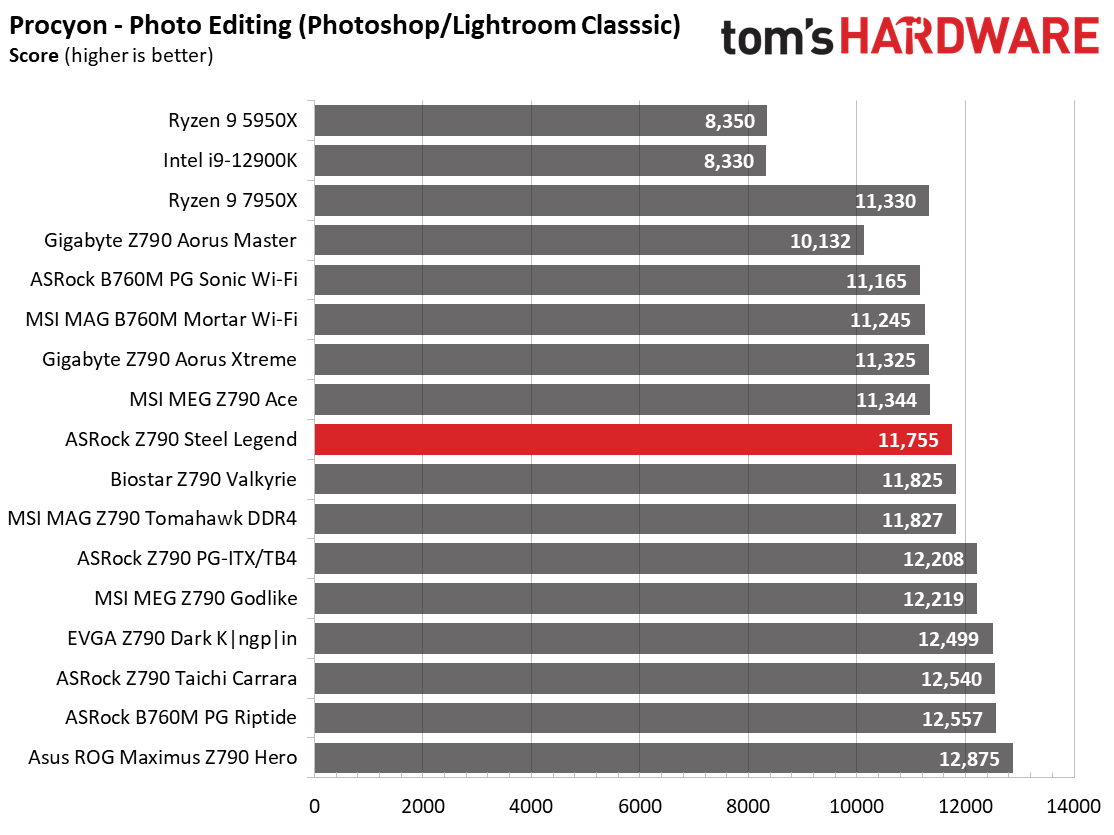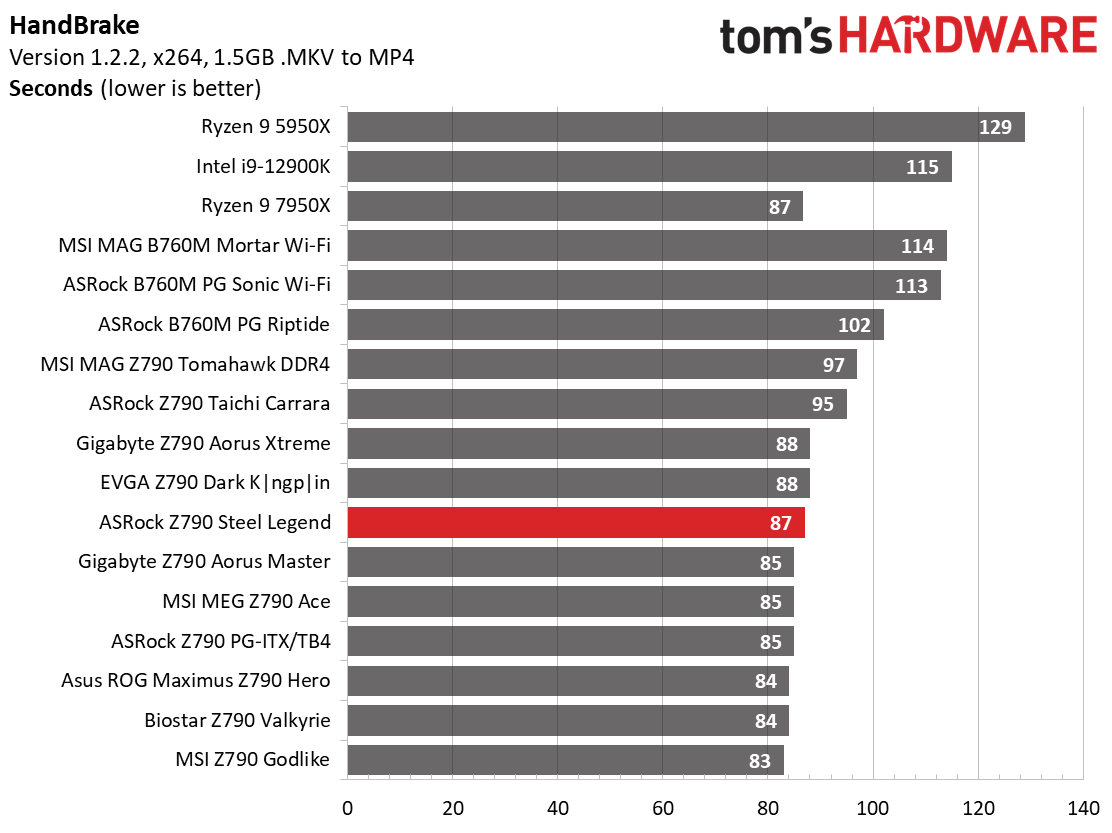Why you can trust Tom's Hardware
Benchmark Results
Our standard benchmarks and power tests are performed using the CPU’s stock frequencies (including any default boost/turbo), with all power-saving features enabled. We set optimized defaults in the BIOS and the memory by enabling the XMP profile. The Windows power scheme is set to Balanced (default), so the PC idles appropriately.
Synthetic Benchmarks
Synthetics provide a great way to determine how a board runs, as identical settings should produce similar performance results. Turbo boost wattage and advanced memory timings are places where motherboard makers can still optimize for stability or performance, though, and those settings can impact some testing.


















In our synthetic results, the Steel Legend proved to be average or slightly below average depending on the test. Results were on the slow side of average in 7-Zip, POV-Ray, Blender, and, surprisingly, in the Procyon Office tests. No results were low enough to cause a problem, they were generally in the bottom half.
Timed Applications




Our timed tests showed similar results, with the LAME and Corona results slightly slower than our average. In contrast, the Handbrake results were spot on average.
3D Games and 3DMark




Starting with the launch of AMD’s Ryzen 7000 platform, we’ve updated F1 21 to F1 22, while keeping Far Cry 6. We run the games at 1920x1080 resolution using the Ultra preset. As the resolution goes up, the CPU tends to have less impact. The goal with these settings is to determine if there are differences in performance at the most commonly used (and CPU/system bound) resolution with settings most people use or strive for (Ultra). We expect the difference between boards in these tests to be minor, with most falling within the margin of error differences. We’ve also added a minimum FPS value, which can affect your gameplay and immersion experience.
Games and 3DMark results were solid, with our Z790 Steel Legend showing off in 3DMark Timespy, posting the highest score we’ve seen. Far Cry: 6’s frames per second was average, while F1 22 was slightly above average. It’s a competent gamer too!
Overclocking
When overclocking, we aim to increase the power and add stress to the VRMs. We do so by increasing the clock speed and voltage until we’re at the thermal threshold for the processor during stress testing. However, where these CPUs are allowed to run with ‘boost’ speeds, those speeds are closer to the limit than ever before.
Get Tom's Hardware's best news and in-depth reviews, straight to your inbox.
With our Core i9-13900K, the approach was a bit different. We had to lower the voltage from what was recorded during stress tests to overclock our chip. We increased the clock speeds of the “P” and “E” cores by 100 and 200 MHz, respectively, over the turbo boost and limited by our cooling. We ended up with 5.6 GHz P core and 4.5 GHz E core clocks using about 1.34V (from DMM). Temperatures peak at or just under the throttling point with this configuration. And as we’ve noted elsewhere, this is the intended performance for Intel’s flagship CPU.
Overclocking on the Steel Legend was as straightforward as most. We settled around 1.32V (less than stock, note) and still had some throttling, but we completed the 30-minute stress test. On the memory side, all three of our kits, including our Teamgroup DDR5-7200 kit, worked by enabling XMP without additional tweaks. I’m impressed the board handles the 7200 kit, as it’s not on the QVL. To ensure compatibility on your system, stick to the QVL!
Power Consumption / VRM Temperatures
We used AIDA64’s System Stability Test with Stress CPU, FPU, Cache and Memory enabled for power testing, using the peak power consumption value. The wattage reading is from the wall via a Kill-A-Watt meter to capture the entire PC (minus the monitor). The only variable that changes is the motherboard; all other parts remain the same. Please note we moved to use only the stock power use/VRM temperature charts, as this section aims to ensure the power delivery can handle the chip even when overclocked. Since we’re using less power to get more clocks, those datasets are more novel than useful. We’re also temperature limited on the processor, so adding more power isn’t possible without increased throttling.
Idle power consumption using the 360/480mm AIO setting in the BIOS yields 65W (an average result), while the load peaked at 395W (slightly on the higher side). Between them both, power use is right around average. Nothing to see here.


VRM temperatures on this board get a bit warm, with the hottest set (on the left of the socket) peaking around 66 degrees Celsius. While this is warmer than some others we’ve tested, it’s still well within the operating parameters of the Intersil SPS MOSFETs. As usual with this platform, the power delivery won’t get in the way of overclocking. CPU temperatures will.
Bottom Line
The Z790 Steel Legend is a good motherboard for the budget-minded user who wants all of the flexibility of the overclockable platform but doesn’t want to spend a ton of money to get there. Along with its neutral black-on-silver appearance and bright RGB lighting, you get all the platform offers, including a PCIe 5.0 slot and M.2 socket (five total on the latter), eight SATA ports, front-panel 20 Gbps USB Type-C, integrated Wi-Fi 6E, a basic audio codec, the eDP port for an additional monitor, and power delivery capable of handling our flagship-class processor at stock or while overclocked.
There is some stiff competition around this price point, however. We have Gigabyte’s Z790 Gaming X AX ($229.99), an Asus Prime Z790-P Wi-Fi ($235.99), and the MSI MAG Z790 Tomahawk Wi-Fi ($289.99). If you’re looking for a superior audio solution, the MSI has you taken care of using the latest-gen codec; otherwise, they all run on the budget ALC897 codec. Outside of that, the most significant difference between these boards is that the Steel Legend is the only one that comes with a PCIe 5.0-capable M.2 socket and eight SATA ports. If you need a lot of storage, the Steel Legend is it, even if you can only run four out of five M.2 slots concurrently.
Around the $230 price, the Steel Legend is one of the most feature-packed Intel Z790 options. Not only do you get a decent neutral appearance with RGBs, but you also get PCIe 5.0 where needed (a slot and an M.2 socket), 10 USB ports on the rear IO, and a 20 Gbps front panel Type-C port, capable power delivery, the unique eDP port, and more. You aren’t going to find another board like this one without spending more, making the Z790 Steel Legend easy to recommend for budget-conscious Z790 shoppers.
MORE: Best Motherboards
MORE: How To Choose A Motherboard
MORE: All Motherboard Content

Joe Shields is a staff writer at Tom’s Hardware. He reviews motherboards and PC components.
-
ocer9999 Good looking motherboard, as long as the VRMs can keep up with the CPU, the performance will be just like most other.Reply -
Mason2501 Reply
Got this mb in October 2022 for my am5 7950x build. Note expo Memory only works in single or pair dd5 chips. So if use all slots you won’t be to use the expo oc settings. Without updating the mb bios those settings can harm x3d CPUs. ASRock does have beta bios that fixes the cpu/ram voltage issue. At some I’ll swap out my 4 16gb ram for two 32gb ram sticks. I just stayed with my 7950x cpu that and RTX 4090 it’s an epic gaming pc. Built in sound is hifi ok and can virtual 3D audio. Plenty of fans and rgb connections. Have three m.2 drives. Pick an li lan 216 rgb white case. ASRock Z790 Steel Legend looks great. Drivers are now stable for windows 11.Admin said:The ASRock Z790 Steel Legend ($229.99) is an affordable option for Intel 12th and 13th-gen processors. The board includes five M.2 sockets (one PCIe 5.0), eight SATA ports, 2.5 GbE and Wi-Fi 6E, capable power delivery, and a budget audio codec. Gaming performance is great, but other tasks were average at best.
ASRock Z790 Steel Legend Review: Legendary for Budget Builds : Read more -
chrysalis I own the z690 version of this board and I find what they did on this version really interesting.Reply
The reason I picked the z690 steel legend is I felt the way they drifted away from the way the industry is going was nice for me, it has extra pcie connectivity which is important for me and kept 8 sata ports.
Now this z790 version, has significantly nerfed the pcie connectivity. On the z690 board you have 2 1x pcie slots, and 3 16x slots, the 3 16x slots run in x16, x4, x4 respectively. I use the second 1x slot for my soundcard, and the 3rd pcie x16 slot (x4) for my pcie SSD which requires 4 lanes.
On the z790 board this isnt possible, the x1 slot I use is removed, and the 3rd x16 slot is only x2 lanes, first time I ever seen a x16 slot on a board only give x2 lanes. Change likely forced by intel's changes which removed 8 gen 3 lanes from the chipset.
The z790 version has a nice change where they added 3 extra type A usb ports, the z690 board is mediocre with only 5, however its another give and take, they removed bios flashback from the z790 board which is there and I used it already on the z690 board.
Finally the z690 board has what I think is a design flaw with the placement of the m.2 wifi slot, any modern 2+ slot GPU will cover it up and cause issues with the fragile wifi antennae cables, I had to be really careful slotting in my gpu, they seem to have realised this on the z790 board as they changed the placement of the slot so the end of the card wont be under the GPU. How they didnt discover this before shipping the Z690 board I dont know.


